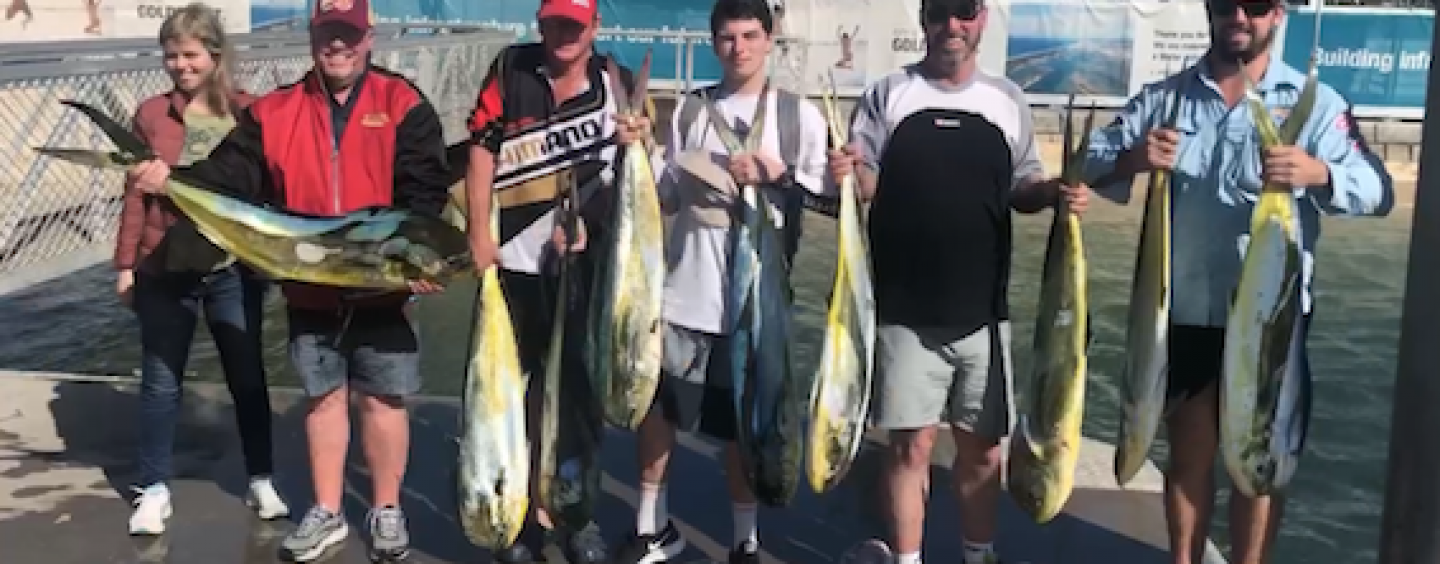With shimmering gold skin, and a body that conjures up an exotic extinct species, the dolphin fish would have to be one of the prettiest fish in the ocean. It also tastes fantastic on the palate.
Dolphin fish are a prolifically fast grower, moving with the warm currents up and down the coastline with other pelagic species during the warmer seasons of the year. Generally found in the tropical and subtropical waters around the globe, this species would have to be one of the most sought-after sportfish by most bluewater anglers.
Wherever you travel, the fish all look the same, but their name changes in different countries. In Hawaii, they are called mahi-mahi; in Mexico, they are known as dorado; and to us down here in Australia, we call them dollies or dolphin fish.
We use light gear when chasing dolphin fish, usually consisting of a reel with quality drag washers and
one that holds a generous amount of line. Shimano reels have this quality and are well known to hold up against big fish, especially when you are using a light line class. The rods have to be light yet sturdy, one that has a flexible tip and a base that can withstand the levering pressure a dolly can put on when taking that first blistering run.
Floating debris is a key factor when it comes to attracting dolphin fish. On the islands, locals use a raft of bamboo and vines, and set it afloat in the current to attract this curious yet adventurous species. Surprisingly, it does not take too long before one, then two – and before you know it, a hundred dolphin fish or more are schooling up under the bamboo raft waiting for the small baitfish to move under for cover.
In some remote waters, anglers actually use sheets of timber with floats tied to the sides to keep it up on the surface. In Australia, certain states actually allow
FADs (fish aggregating devices) to be placed along the reefs. Some state fisheries departments actually build them and set them out for anglers to fish around. Unfortunately, in Queensland, we are behind the times and that has not eventuated. The ones you do find out at sea are illegally put there by anglers wanting to get among the action. And if you do come across a float tied to a piece of rope in the middle of nowhere full of dolphin fish, do yourself a favour and remember the saying, ‘Loose lips sink ships’.
In the sense of lure choices, we prefer small resin head lures or live baits. It is pretty unusual to see a dolphin fish pass up a piece of pilchard floated out in a burly trail.
As we come into the warmer months of the year, we will start to see more and more dolphin fish being caught by everyday anglers. Most of the fish taken from our shallow waters off the coastline range from three to eight kilos. But as you head further out to sea, their sizes increase dramatically
to monstrous lengths and weights. Big males or bull dolphin fish have mammoth heads that look very much prehistoric. Once hooked up, the fish can easily strip you of all your line in a matter of minutes. A heavier line class is required to tackle these fish, especially when we are talking about a fish in the category of 30 kilos or more.
Once close to the boat, the colours of dolphin fish are simply mesmerising. Iridescent blues, greens and yellows light up the water. If you have another rod handy with either a bait or a lure attached to it, you can have yourself a bit of fun with his mates that generally follow them back to the boat.
Dolphin fish are a schooling predatory species and they will fight all the way to the end. They will muscle over each other to get to the bait first. But if you lose one, it is a sure sign that the rest of the school will go off the bite for a while.
Baiting the fish is as hard as the fight and this is where it becomes dangerous. With a stream-like body and a powerful head and tail shake, the dolphin fish can easily embed a hook – or three – straight into your leg or hand when trying to restrain it from flipping about. Generally, a quick knock to the head with a batten or nulla-nulla will quiet them down, but they must be bled immediately and placed straight on ice.
In our neck of the woods, anglers fish the waters around the Kirra Bay region and further out along the 36 and 50 fathom line. where the cobalt waters flow down from the north.
You need to have some knowledge of where they are congregating before heading out. Ask the team members at your local Anaconda store if there are any dollies being caught. If not, usually they are among other species such as marlin, mackerel and tuna, so you may get a mixed bag when out trolling.
A top fish and some top fun for anglers in summer!
By Paul Burt
Published in the Jan-March 2020 edition.



























